“Ninety percent of 40 large corals were heavily affected and showed dead and dying parts and discoloration.”
- Charles Fisher, Ph.D., Prof. of Biology, Penn State

November 23, 2010 University Park, Pennsylvania - On April 20, 2010, the BP Deepwater Horizon drilling rig exploded. Eleven men working on the platform died and 17 others were injured. Over the next three months, some 53,000 barrels of crude oil per day gushed uncontrollably into the Gulf of Mexico from BP's exploratory Macondo well blowout a mile down on the sea floor. When a cap on the Macondo well finally worked on July 15, 2010, at least 4.9 million barrels (185 million gallons), combined with the controversial chemical dispersant called Corexit, had soiled the Gulf waters and covered birds and marine life with the slimy goo.
Click here to subscribe and get instant access to read this report.
Click here to check your existing subscription status.
Existing members, login below:
© 1998 - 2025 by Linda Moulton Howe.
All Rights Reserved.

